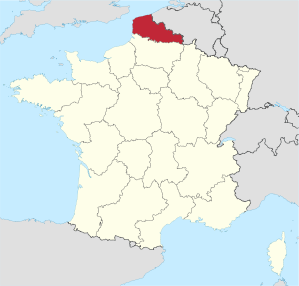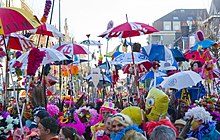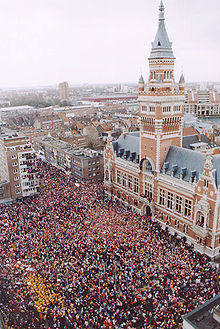Nord-Pas-de-Calais
|
Nord-Pas-de-Calais Former French region (until 2015) |
|

|

|
| Basic data | |
|---|---|
| Today part of | Hauts-de-France |
| Administrative headquarters | Lille |
|
population
- total January 1, 2017 |
4,072,379 inhabitants |
|
surface - total |
12,414 km² |
| Departments | 2 |
| Arrondissements | 13 |
| Cantons | 156 |
| Communities | 1,545 |
| Formerly ISO 3166-2 code | FR-O |
Nord-Pas-de-Calais [ nɔʀpɑdkaˈlɛ ] was the northernmost region of France . She lay on the border with Belgium and existed until the end of 2015 from the departments of Nord and Pas-de-Calais . The region had an area of 12,414 km² and 4,072,379 inhabitants (as of January 1, 2017), its capital was Lille . With Dunkirk , the region had the third largest port in France. Since January 1, 2016, the Nord-Pas-de-Calais region has been united with the Picardy region . After a transition phase under the name of Nord-Pas-de-Calais-Picardie, the newly formed region was renamed Hauts-de-France by resolution of September 28, 2016 .
geography
Other important cities besides Lille were in the Nord-Pas-de-Calais region Arras , Calais , Boulogne-sur-Mer , Dunkirk (Dunkerque), Cambrai , Douai and Valenciennes .
coat of arms
Description: In gold, a black, red-tongued and armored lion . The coat of arms of the Nord-Pas-de-Calais region is almost identical to the emblem of the neighboring region of Flanders in Belgium . It points to the partly Flemish origin of the Nord-Pas-de-Calais region.
history
Nord-Pas-de-Calais was created in 1960 with the establishment of the regions in France. In 1972 the region received the status of an établissement public under the direction of a regional prefect. The decentralization laws of 1982 gave the regions the status of collectivités territoriales ( territorial authorities ), which until then had only been enjoyed by the municipalities and the départements . In 1986 the regional councils were directly elected for the first time. Since then, the region's powers vis-à-vis the central government in Paris have been gradually expanded.
In the Nord-Pas-de-Calais region were the French parts of Flanders ( French Flanders ) and Hainaut as well as the Artois landscape . They have all belonged to France only since 1678. Before that they were part of the Burgundian or Spanish Netherlands . This region also includes the Boulonnais landscape with the important port cities of Boulogne and Calais .
With effect from January 1, 2016, the Picardy region merged with the Nord-Pas-de-Calais region to form a new region called Hauts-de-France (from January to September 2016 provisionally Nord-Pas-de-Calais-Picardy ).
population
Demographics
The region had 4 million inhabitants (7% of the population of France). The population density of 325 inhabitants per km² took second place among France's regions after Île-de-France . Because of the high birth rate, the population of Nord-Pas-de-Calais was the youngest of the regions in France : 36.5% of the population were less than 25 years old (the national average is 32.4%). Nevertheless, the regional population decreased due to high emigration.
language
There were three dialects in the region:
- The Picardic language , also called "Ch'ti" or "Patois".
- The Dunkerquois, a mixture of French and Flemish ; it is mainly spoken near Dunkerque .
- The Flemish spoken in French Flanders .
Cities
The most populous cities in the Nord-Pas-de-Calais region:
| city | Inhabitants (year) | Department |
|---|---|---|
| Lille | 232,787 (2017) | North |
| Roubaix | 96,990 (2017) | North |
| Tourcoing | 97,368 (2017) | North |
| Dunkerque | 87,353 (2017) | North |
| Calais | 73,911 (2017) | Pas-de-Calais |
| Villeneuve-d'Ascq | 63,408 (2017) | North |
| Valenciennes | 43,336 (2017) | North |
| Boulogne-sur-Mer | 40,874 (2017) | Pas-de-Calais |
| Douai | 39,700 (2017) | North |
| Wattrelos | 40,958 (2017) | North |
| Arras | 41,019 (2017) | Pas-de-Calais |
Political structure
The Nord-Pas-de-Calais region was divided into two departments :
| Department | prefecture | ISO 3166-2 | Arrondissements | Cantons | Communities | Inhabitants (year) | Area (km²) |
Density (inh / km²) |
||
|---|---|---|---|---|---|---|---|---|---|---|
| North | Lille | FR-59 | 6th | 79 | 650 |
|
5,743 | 453.5 | ||
| Pas-de-Calais | Arras | FR-62 | 7th | 77 | 895 |
|
6,671 | 220.1 |
economy
After the Second World War , the region ran into economic difficulties. Coal , metallurgy and the textile industry have been the most important branches of the economy since industrialization in the 19th century, along with extremely profitable agriculture . Only a few textile companies remained. Although the TGV and Eurotunnel contributed to new dynamism, unemployment at 12.6% was higher than the national average (9.1%; January 2010).
Several French companies have their headquarters in the region:
- Auchan ( Croix )
- Decathlon ( Villeneuve-d'Ascq )
- La Redoute ( Roubaix )
- 3 Suisses ( Croix )
- Bonduelle ( Villeneuve-d'Ascq )
- Arc International (Arques)
- Roquette Frères ( Lestrem )
traffic
- Eurotunnel : The region has been connected to Great Britain via the Eurotunnel since 1994.
Culture
Attractions
The northern French coal mining area has been a UNESCO World Heritage Site since 2012 . Since 1999, UNESCO has protected 17 belfries in the region.

|
Belfry of Armentières
Listed as a historical monument since 1999 |

|
Belfry of Bailleul
Listed as a historical monument since 1999 |

|
Belfry of Bergues
Listed as a historical monument since 1999 |
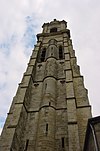
|
Belfry of Cambrai
Listed as a historical monument since 1999 |

|
Belfry of Comines
Listed as a historical monument since 1999 |

|
Belfry of Douai
Listed as a historical monument since 1999 |

|
Dunkirk Belfry (Church of St. Eloi)
Listed as a historical monument since 1999 |
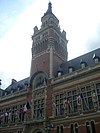
|
Beffroi de l'Hôtel de Ville de Dunkerque (Belfry of the City Hall of Dunkirk)
Listed as a historical monument since 1999 |
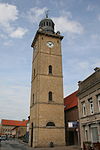
|
Belfry of Gravelines
Listed as a historical monument since 1999 |
Belfry of Lille
Listed as a historical monument since 1999 |
|

|
Belfry of Loos
Listed as a historical monument since 1999 |
Belfry of Aire-sur-la-Lys
Listed as a historical monument since 1999 |
|
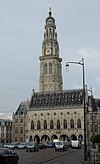
|
Belfry of Arras
Listed as a historical monument since 1999 |

|
Belfry of Béthune
Listed as a historical monument since 1999 |

|
Belfry of Boulogne-sur-Mer
Listed as a historical monument since 1999 |
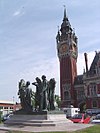
|
Belfry of Calais
Listed as a historical monument since 1999 |

|
Belfry of Hesdin
Listed as a historical monument since 1999 |
Citadel of Arras
Fortification by Vauban Listed as a historical monument since 2008 |
|

|
Reuze Papa , giant of Cassel
Listed as a historical monument since 2005 |
Gayant et Marie Cagenon, giant of Douai
Listed as a historical monument since 2005 |
In 2012 the Louvre-Lens opened in Lens with numerous works of art that had previously been shown in the Louvre in Paris .
Regular events
- Carnival in Dunkerque , from mid-January to late March
- Enduro du Touquet , February
- Carnival in Bailleul , February / March
- Gayant folk festivals in Douai , June / July
- Lille Braderie , September
Movie
Nord-Pas-de-Calais is the location of the 2008 very successful cinema comedy Welcome to the Sch'tis . For the post office clerk Philippe Abrams ( Kad Merad ), the work in Nord-Pas-de-Calais meant a punitive transfer to Bergues , where it was difficult for him to understand anything at all due to the language of the French north, which he did not understand. The film owes its name to the “Ch'ti” dialect .
Visual arts
For the entire region was in the port of Dunkirk , the FRAC Nord-Pas de Calais set up a large collection of contemporary art. This is preceded by the LAAC , located near the city and port of Dunkirk , which shows modern art from the period 1940 to 1980.
Sports
Soccer
The Nord-Pas-de-Calais region has always been one of France's football strongholds.
With Lille OSC , RC Lens and Valenciennes FC , three clubs from Nord-Pas-de-Calais currently play in Ligue 1 , the first and top division of French professional football. Lille OSC won the French championship in the 2010/11 season. A few weeks earlier, the French Cup could also be won. The RC Lens became French champions in 1998 and, after being promoted and relegated twice, has been back in Ligue 1 since the 2014/2015 season. Valenciennes FC has been a member of Ligue 1 since 2006. Before that, the club was shuttled between Ligue 1 and Ligue 2 .
See also
- List of presidents of the Regional Council of Nord-Pas-de-Calais since 1986
- Université Lille Nord de France
Web links
- Nord-Pas de Calais region (French)
- Prefecture of the Nord-Pas de Calais region (French)
- Northern France Official Website (German)
Individual evidence
- ↑ [1]
- ↑ Insees unemployment rate in 2010 ( French ) INSEE. Retrieved January 7, 2010.
Coordinates: 50 ° 21 ' N , 2 ° 53' E
